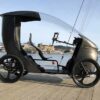The MIT city ebike transitions from one configuration to the other
26.10.2020
1627
The idea of MIT Autonomous city ebike is that clients would initially summon the closest available e-bike to their present location, via an app. Guided by GPS that e-bike would autonomously make its way to them with its rear wheels spread apart from one another, allowing it to function as a self-driving tricycle.
The MIT Autonomous city ebike has a mechanical attachment that allows it to shift easily from bicycle mode (when in use) to tricycle mode (when the user dismounts, and the bicycle rides to its next destination). The bike transitions from one configuration to the other using two linear actuators that separate and rejoin the wheels as needed. The prototype also includes electric motors to propel the bike when it is in autonomous mode: a hub motor to drive the front wheel and a second motor for steering.
While bicycle-sharing systems certainly are proving to be popular, they still have a few problems, such as the limited availability of bikes. Researchers at the MIT Media Lab are working on a solution, in the form of the MIT Autonomous city ebike.
Upon reaching the user destination, two linear actuators would automatically pull the bicycle’s rear wheels back in together, essentially converting them into one wide rear wheel. The user may would then ride the bike to their destination, with the steering motor inactivated. Once they finished it, the bike would go back into trike mode, proceeding on to its next user or the closest charging station.
The prototype of the autonomous city ebike has already been successfully tested on the MIT campus.
Look at https://www.media.mit.edu












